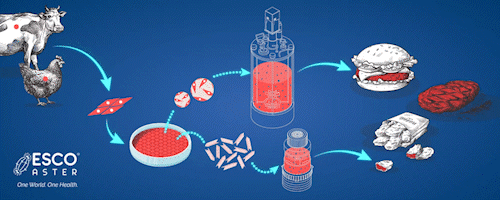For over a million years, mankind has been consuming different types of meat and it has greatly benefited us. However, the current view on meat consumption is recognized to put pressure on crop output with a surmountable environmental effect due to greenhouse gas emissions. With an increase in demand over the coming decades, it is questionable whether livestock meat production can meet the hungry population.
As a consequence, the meat of the future will likely be grown de novo compared to the traditional methods of obtaining meat. Cultured meat, sometimes called lab-grown meat, clean or cultivated meat, is grown in a laboratory by culturing a few animal cells into a bioreactor. This idea doesn’t require many environmental resources such as water, grass, or land and it is real meat, obtained without slaughter.
The ‘Meat’ comes from culturing skeletal muscle and fat tissue precursor cells from the chosen meat source. These originating cells can come from a chicken, cow, pig, ducks among others, and can be grown outside of an animal’s body. The cells will then expand through proliferation in an optimized culture environment and be harvested as it becomes meat.
Different manufacturing companies deploy a variety of sources for obtaining specific cells. Cultured meat begins with extracting cells from a tissue, mostly from stem cells. These cells can be taken from cell banks, pieces of fresh meat, a feather, or other sources. The goal is to culture the specific cell line that is fast-growing and tasty.
The cells are bathed in an optimum liquid containing nutrients to help them duplicate and proliferate to the point of resembling meat. The growth medium to be used is critical as it contains the necessary sugars, vitamins, proteins, and amino acids that cells require to grow and proliferate.
Burger patties, nuggets, or even steak cultivated to become meat are usually ‘unstructured’ when developed. As more and more companies try to make cultured meat realistic, some use scaffolds that are either edible or soluble. Most of which are made from gelatin, soy protein, mushroom roots, and more.
Depending on the cell type, bioreactors are equipment used where cells can grow and proliferate in an environment that is similar to where the cells were isolated from. Critical factors such as pH, temperature, agitation, and dissolved oxygen needed for cells to survive are automatically controlled and monitored in these systems.
As the aim is to feed the population, large-scale systems should be available and guidelines for manufacturing should be met. Depending on the process workflow, either single use or multiple use systems are used to cater to each requirement and manufacturing step. Single use systems like Tide Motion bioreactors work best to avoid validation run time and costs, as well as sterilization procedures needed before starting the next batch run. Multiple use systems such as stirred-tank bioreactors are available on a manufacturing scale of up to 20,000 L, making them suitable for large scale production of meat.

Figure 1. An infographic on how cultured meat is produced. It starts with harvesting or getting cells from a chosen animal that shows replicative activity. Then, these cells are cultured first in 2D systems and transferred in commercial bioreactors for large scale manufacturing. After certain number of days, cell mass is produced which will be formed to become meat.
Cultured meat is not clean meat for nothing. Nutritional factors such as fat and cholesterol can be controlled which may lead to potentially positive health outcomes. The meat can also be fortified with essential vitamins and minerals for optimum nutrition.
Aside from this, there are some potential benefits listed for cultured meat:
Of course, there are several factors to be considered as to whether one will accept or reject cultured meat. The consumer perception is still debating on the ethical, naturalness, and religious considerations for eating cultured meat.
Whether you are now asking whether clean meat is the way to go if you are in for a healthier, kinder, and more sustainable solution to address the demands of the world, why not try it? Cellular agriculture has the potential to evolve and to progress out of its infancy. Whether cultured meat is competitive to conventional meat? There’s only one way to find out. Meet the ‘Meat’ Today.
Learn more about our AsterMavors platform and how you can step up your next cellular agriculture or alternative protein manufacturing.
Sign up to our newsletter and receive the latest news and updates about our products!
